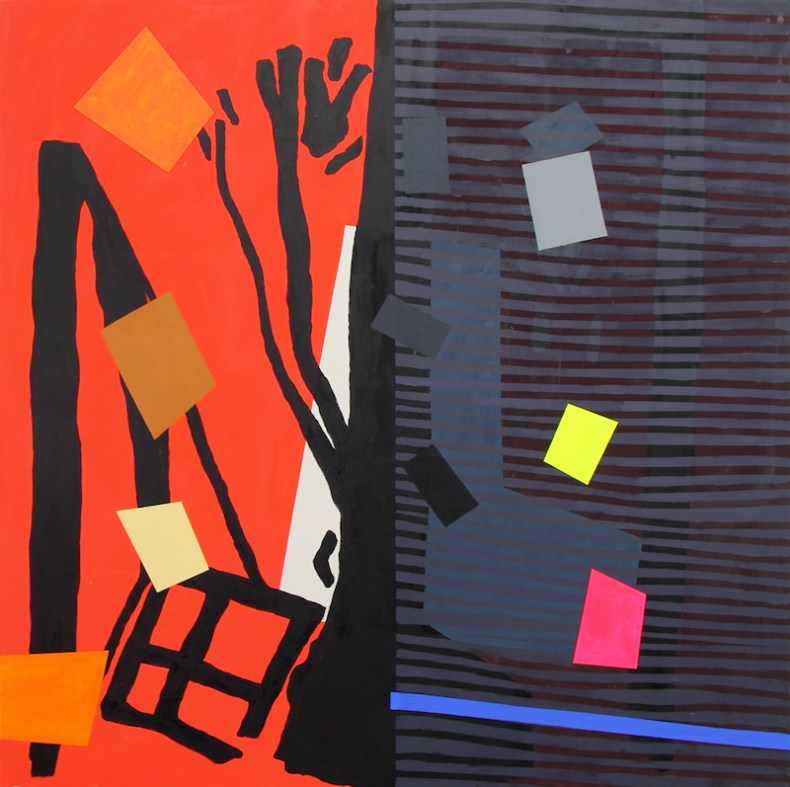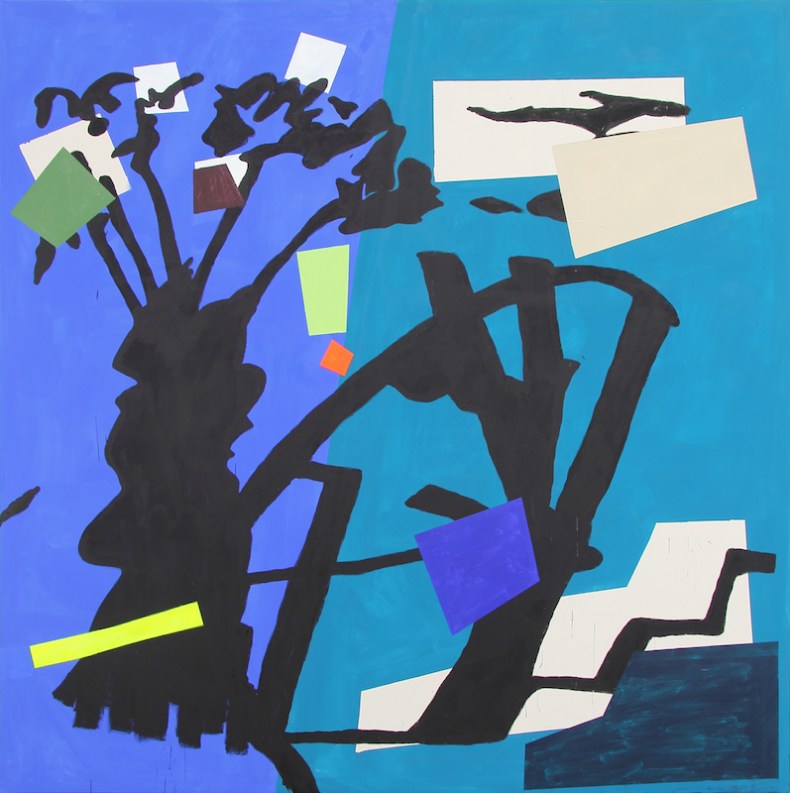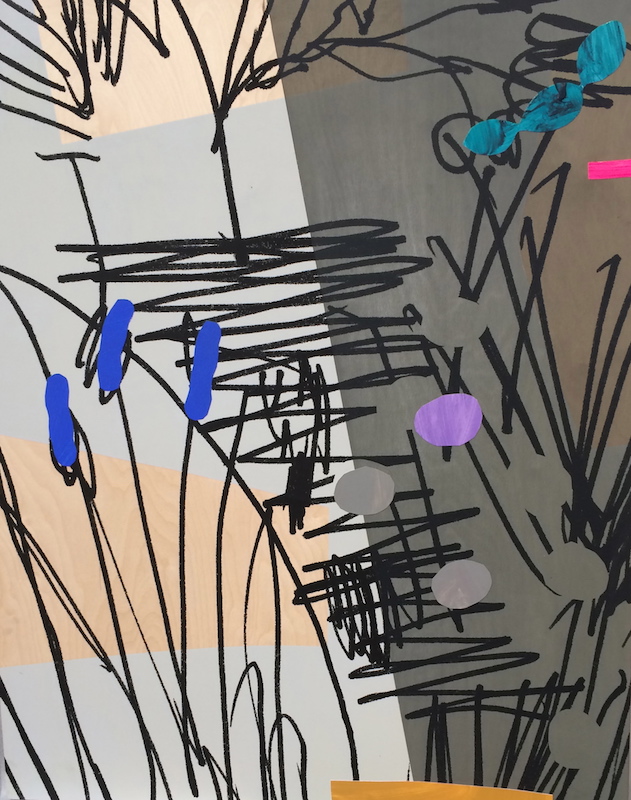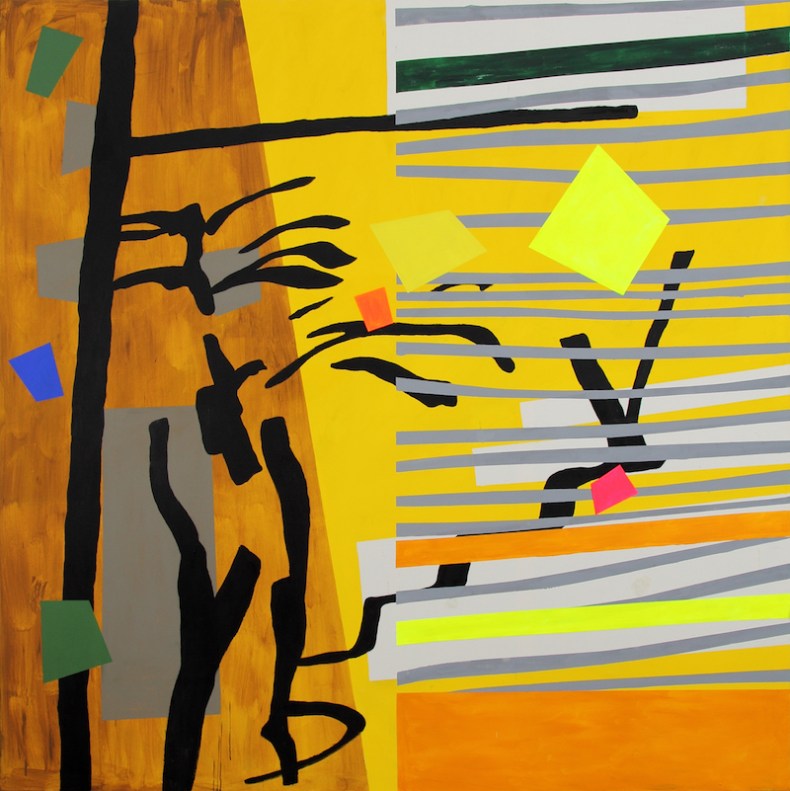It is early December in London when I meet Bruce McLean to discuss his exhibition of new works at Bernard Jacobson Gallery. Stepping into the gallery, I am transported to much warmer climes. McLean’s paintings fill the airy white rooms of the gallery and are dominated by thick, heavy lines and shapes in colours charged with heat: vivid blues, deep oranges and pinks and blacks. The title of the exhibition, ‘A Hot Sunset and Shade Paintings’, further evokes a place far away from the wintry British isles.
This is no coincidence. While McLean, who is originally from Glasgow, spends most of his time working from a studio in West London, he also has a studio on the Spanish island of Menorca in the Mediterranean Sea. It was on this island that the new series of works originated. The two vast sunset or ‘stripe’ paintings, composed of rows of long, horizontal painted blocks of varying colours, widths and depths, clearly represent some sort of horizon. ‘I sit in the landscape looking at the sea quite a lot…not looking at it for inspiration, just looking at it because it’s so fantastic…You don’t realise what you’re doing sometimes, it sort of impregnates you, influences you subconsciously.’

Shade Painting: Red (2016), Bruce McLean. Courtesy of Bernard Jacobson Gallery
Meanwhile, a second series of square canvases and related monoprints contains a wider range of imagery: stripes return, but here they are layered above and beneath the scribbled outlines of trees and hills, window-frames and other more abstract shapes. McLean explains how these paintings came about: ‘I made these drawings – scribbles of things in my garden and up in the fields, of shadows – not with any particular end in mind…I made some silkscreen prints from the drawings, and then I did something which I’d never done before – I got some prints that I liked, and I made some paintings from them. The prints became the source for the paintings.’ Although painted in oil on canvas, the flat geometric blocks of the ‘shade’ paintings clearly recall the very different process of printmaking. Wary that his description of the process behind a work might be less interesting than discussions of seas and sunsets, McLean interrupts himself: ‘If I’m getting too boring or tedious shut me up.’

Shade Painting: Blue (2016), Bruce McLean. Courtesy of Bernard Jacobson Gallery
Far from boring, it seems to me that this experimentation, a merging of different materials and processes that reveals the specific character of a medium and pushes at the limits of its possibilities, is one of the most interesting elements of McLean’s work. This is the man who, after all, began his career in the 1960s making sculptures out of surprising materials: rubbish, water, and his own body, as in the celebrated Pose Work for Plinths (1971), based on a performance at the Situation Gallery. One of these photographs, depicting McLean’s bodily contortions as he attempts to replicate the poses of Henry Moore’s reclining figures on plinths, was recently exhibited in ‘Conceptual Art in Britain 1964–79’ at Tate Britain. McLean however, tells me that he finds conceptual art to be a ‘strange’ term. Isn’t everything conceptual? And, more importantly, he doesn’t really believe in making art at all. ‘I think what I do is a development into sculpture and an inquiry into sculpture…Whether it’s art or not…I would question that.’

Grey Garden (2016), Bruce McLean. Courtesy of Bernard Jacobson Gallery
There seems to be a gulf between McLean’s earlier works, in which he experimented with performance, filmmaking and minimalist sculpture, and these more recent paintings. McLean politely disagrees – ‘I am a sculptor’ he tells me – stressing his own sense of artistic coherence. For McLean, the two-dimensional shade paintings are sculptural, explorations of light and shadow as physical, almost tangible entities in space. And, together, the sunset and the shade paintings are – in his head at least – ‘paintings towards a new kind of sculpture.’ What is this new sculpture? McLean tells me that he hopes to make a series of sculptures out of the bars of the sunset paintings, and to experiment with cutting-up and reassembling images of the shade paintings to create real shadows in three-dimensional space. It’s no surprise that he cites Matisse’s late cut-outs as an influence. There is, in fact, a distinctly sculptural quality to the sunset paintings, with their undulating three-dimensional surfaces made up of painted bars – McLean, typically unpretentious, describes them as ‘real lumps of stuff’.

Shade Painting: Yellow (2016), Bruce McLean. Courtesy of Bernard Jacobson Gallery
The vitality and energy of McLean’s paintings comes not just from their vibrant colours and the mediterranean landscape they depict, but from the artist’s own sense that the works, while individually complete, are part of an ongoing process of inquiry and experimentation. Suddenly, the distance between the young McLean – the so-called radical conceptualist and performance artist – and the painter of fields and horizons sitting before me fades away. This is undeniably the same man: painter, printmaker, ceramist and sculptor – but don’t call him an artist!
‘Bruce McLean: A Hot Sunset and Shade Paintings’ is at Bernard Jacobson Gallery, London, until 28 January 2017.












![Masterpiece [Re]discovery 2022. Photo: Ben Fisher Photography, courtesy of Masterpiece London](http://zephr.apollo-magazine.com/wp-content/uploads/2022/07/MPL2022_4263.jpg)
Apollo at 100